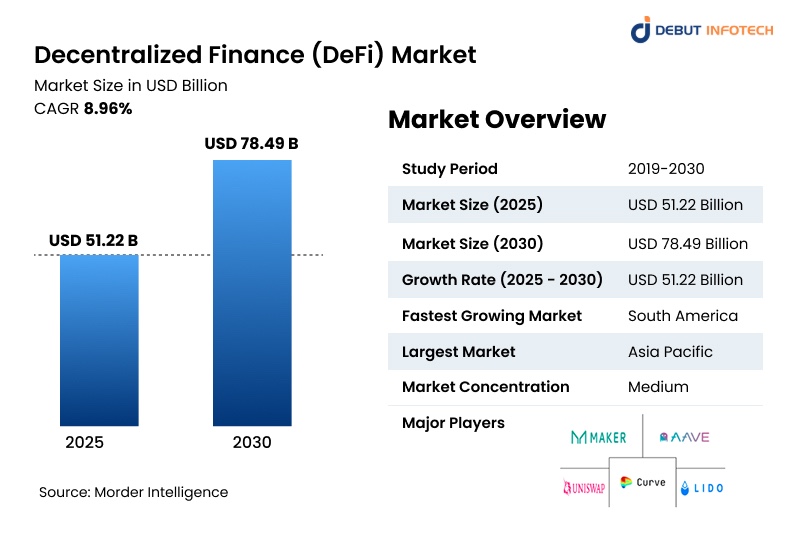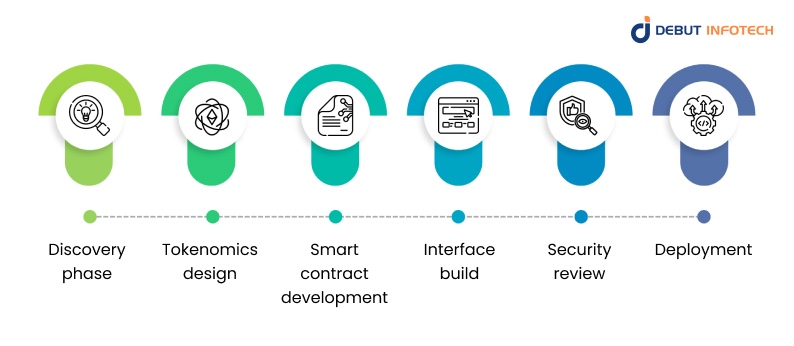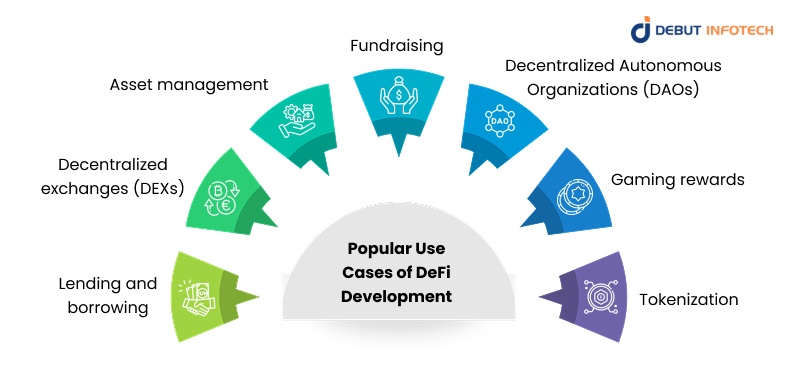Table of Contents
Home / Blog /
What is DeFi Development: What You Need To Know
October 13, 2025

October 13, 2025
DeFi development is reshaping financial systems by replacing intermediaries with blockchain-powered solutions that are transparent, accessible, and secure.
According to a Mordor Intelligence report, the global DeFi market, valued at USD 51.22 billion in 2025, is projected to grow to USD 78.49 billion by 2030 at a CAGR of 8.96%. In May 2025, over 27 million unique wallets used DeFi protocols, a record high. This surge reflects growing trust in decentralized technologies that power lending platforms, decentralized exchanges, and tokenized assets.

By using smart contracts, dApps, and liquidity pools, DeFi enables businesses and users to transact seamlessly without traditional banks. Developers and enterprises investing in DeFi solutions today are not just adopting a trend but building the financial infrastructure of tomorrow.
In this guide, we will explore DeFi Development, its core components, development stages, use cases, challenges and solutions, as well as where the sector is headed.
Ready to Turn Your DeFi Idea Into Reality?
Our experts design and launch secure, scalable DeFi solutions that help you stand out in the blockchain market.
What is DeFi Development?
Decentralized Finance (DeFi) development is the process of designing financial systems that operate on blockchain networks without intermediaries.
It involves creating platforms where transactions are powered by smart contracts rather than centralized authorities, ensuring transparency, efficiency, and security.
DeFi development spans multiple domains, from token creation and liquidity provision to governance and asset management, offering a structured path toward more inclusive financial services.
Key Components of DeFi Development
DeFi development solutions require strong foundations. These components define system integrity, user trust, and long-term scalability, making them essential in every project’s lifecycle.
1. Defi tokens
DeFi tokens are digital assets designed for specific use cases, such as payments, staking, or governance participation. They enable users to earn rewards, access liquidity, and influence platform decisions. By embedding functionality into tokens, defi tokens development teams create economic systems that drive engagement, ensure fairness, and support sustainable platform growth.
2. Smart contracts
Smart contracts are self-executing programs stored on blockchains that automatically enforce agreements once predefined conditions are met. They remove reliance on intermediaries, reducing costs and risks of fraud. In DeFi, they power core functions like lending, swapping, or collateral management, making financial transactions more efficient, transparent, and trustworthy.
3. Decentralized applications (dApps)
dApps are blockchain-based platforms offering financial services directly to users without centralized intermediaries. They support functions such as trading, borrowing, asset management, and gaming incentives. Built on smart contracts, dApps deliver trustless, permissionless access, giving users complete control over assets while ensuring transparency, security, and autonomy in financial interactions.
4. Liquidity pools
Liquidity pools are collections of tokens locked in smart contracts to facilitate decentralized trading, lending, or yield farming. They allow users to contribute assets, earning transaction fees or incentives in return. By removing reliance on traditional market makers, liquidity pools improve efficiency, enable seamless token swaps, and stabilize decentralized ecosystems.
5. DeFi wallets
DeFi wallets are non-custodial tools that allow individuals to manage digital assets independently, without third-party control. They connect users directly to decentralized applications, enabling lending, trading, and staking. With features like private key ownership, multi-asset support, and dApp integration, DeFi wallet development provides secure, user-friendly gateways into decentralized financial systems.
The DeFi Development Process

Developing DeFi applications involves structured phases, each focused on reliability, compliance, and efficiency. They are:
1. Discovery phase
The discovery phase involves outlining project objectives, identifying the target audience, and reviewing compliance needs. Teams assess technical requirements, potential risks, and market opportunities. This stage ensures alignment between business goals and technical capabilities, forming the defi foundation for a solution that meets both user expectations and industry standards.
2. Tokenomics design
Tokenomics defines how a platform’s native token will function, covering supply, distribution, and incentives. Careful design balances utility with sustainability, ensuring liquidity, engagement, and fairness. Well-structured tokenomics supports governance participation, rewards early adopters, and drives adoption by creating a self-sustaining economic ecosystem that keeps users invested in long-term growth.
3. Smart contract development
Smart contract development transforms planned features into executable blockchain code. When you hire Defi Developers, they help to write, test, and refine contracts that power lending, trading, or staking.
Security audits are conducted during this stage to prevent exploits. Successful contract deployment ensures reliability, transparency, and automation, removing the need for intermediaries in financial processes.
4. Interface build
The interface build focuses on creating user-friendly web or mobile platforms that interact seamlessly with smart contracts. Clear navigation, responsive design, and integrated wallet support are prioritized. By reducing complexity, this step makes decentralized platforms more accessible, attracting a broader audience and improving overall user experience within the ecosystem.
5. Security review
A security review ensures that vulnerabilities are identified and resolved before launch. This step includes code audits, penetration testing, and simulations to evaluate performance under different conditions. By addressing risks early, developers build trust and credibility, reassuring users that their assets and data remain safe on the platform.
6. Deployment:
Deployment marks the official release of the DeFi platform on a chosen blockchain. This stage involves launching smart contracts, activating the interface, and connecting wallets. Post-deployment monitoring and updates are essential to maintain stability. Continuous improvements ensure the system adapts to changing demands while safeguarding long-term sustainability and growth.
Popular Use Cases of DeFi Development

DeFi continues to expand, transforming how people borrow, trade, invest, and manage assets by offering alternatives to traditional financial structures. Here are some popular DeFi use cases:
1. Lending and borrowing
DeFi lending and borrowing platform development allows users to earn interest on deposits or take collateralized loans without intermediaries. Smart contracts manage loan terms and collateral, reducing the risks of default. This open model democratizes credit access, while investors benefit from higher yields than traditional savings and lending options.
2. Decentralized exchanges (DEXs)
DEXs facilitate peer-to-peer token swaps without centralized control, relying on automated market makers and liquidity pools. Users maintain custody of assets throughout the process, enhancing security and transparency. By eliminating intermediaries, DEXs reduce costs, increase accessibility, and provide global, around-the-clock trading opportunities for a wide range of digital tokens.
3. Asset management
DeFi asset management tools help users track portfolios, optimize yields, and automate investment strategies. The best defi platforms aggregate data from multiple protocols, simplifying decision-making for individuals and institutions. Features like yield farming, rebalancing, and analytics empower investors to maximize returns while maintaining control, reducing dependency on traditional wealth management services.
4. Fundraising
Fundraising in DeFi is achieved through mechanisms such as Initial DEX Offerings (IDOs) or liquidity bootstrapping pools. These models allow startups and protocols to secure funding directly from global participants. By bypassing venture capital and banks, DeFi fundraising improves accessibility, transparency, and community-driven participation in early-stage project growth.
5. Decentralized Autonomous Organizations (DAOs)
DAOs provide community-driven governance for DeFi projects. Token holders vote on proposals, shaping protocol upgrades, treasury allocation, and strategic decisions. This structure promotes transparency and inclusivity while reducing reliance on centralized leadership. DAOs align incentives, empowering users to influence long-term project direction and ensure democratic decision-making within ecosystems.
6. Gaming rewards
DeFi-powered gaming integrates play-to-earn models, rewarding players with tokens or digital assets for in-game achievements. These rewards can be traded, staked, or reinvested across DeFi platforms. By combining entertainment with financial incentives, blockchain gaming encourages user engagement, fosters vibrant communities, and introduces new pathways for digital ownership.
7. Tokenization
Tokenization converts physical or digital assets into blockchain-based tokens that can be traded or used within DeFi ecosystems. Assets like property, bonds, or artwork gain liquidity and fractional ownership. This approach reduces barriers to investment, improves market efficiency, and bridges traditional asset markets with decentralized financial infrastructure.
Challenges in DeFi Development and Their Solutions
DeFi offers massive opportunities but comes with real challenges. Addressing defi development challenges with practical strategies is vital for creating trusted and scalable DeFi solutions.
1. Security Concerns
DeFi platforms remain vulnerable to smart contract bugs, flash loan exploits, and hacking attempts. These risks undermine user trust and can cause severe financial losses. Without strong safeguards, vulnerabilities may discourage wider adoption and limit DeFi’s credibility as a secure alternative to traditional financial systems.
Solution:
Mitigating security risks requires comprehensive smart contract audits, bug bounty programs, and continuous monitoring of deployed code. Multi-layered defense strategies, such as insurance funds and risk controls, further strengthen resilience. By prioritizing security, projects build confidence, encouraging users and investors to engage more freely with DeFi platforms.
2. Scalability and Performance
High network congestion and elevated transaction fees often limit DeFi’s usability. When blockchain throughput is restricted, users experience delays, inefficiencies, and higher costs. These performance issues prevent platforms from supporting larger volumes of activity and hinder DeFi from competing effectively with traditional financial infrastructures.
Solution:
Adopting Layer 2 scaling solutions like rollups, sidechains, and sharding helps reduce costs and accelerate transactions. Optimizing smart contract design can also improve efficiency. By implementing scalable architecture, DeFi platforms can handle greater demand while delivering faster, cost-effective services that attract mainstream participation and institutional interest.
3. User Experience (UX)
Complex wallet setups, technical interfaces, and unclear instructions deter everyday users. Navigating DeFi often requires technical expertise, creating barriers for mass adoption. Without accessible and intuitive designs, DeFi platforms struggle to attract non-technical participants, limiting growth to a small segment of crypto-savvy individuals.
Solution:
Improving UX involves creating user-friendly dashboards, simplifying wallet connections, and integrating educational guides within platforms. Mobile-first decentralized apps (dApps) and intuitive onboarding processes expand accessibility. By prioritizing simplicity and guidance, DeFi app development projects can attract mainstream users and ensure broader participation without sacrificing security or functionality.
4. Integration with Traditional Finance (TradFi)
DeFi platforms face challenges in bridging with traditional banking systems. Limited interoperability restricts services like fiat on-ramps, credit assessments, and institutional-grade compliance. Without effective integration, DeFi risks remaining isolated, reducing its ability to compete with established financial structures or attract broader institutional partnerships.
Solution:
Solutions include developing hybrid models that combine DeFi’s transparency with TradFi’s regulatory frameworks. Partnerships with payment providers and regulated exchanges enable fiat gateways. By aligning with financial standards, DeFi platforms improve trust, expand market reach, and position themselves as complementary rather than competing systems to TradFi.
5. Governance and Consensus
Many DAOs struggle with low voter participation and centralization of decision-making power. Inactive communities and dominance by large token holders create governance inefficiencies. Poor consensus processes hinder protocol upgrades and weaken the democratic promise of decentralized organizations, leading to stagnation or misaligned project directions.
Solution:
Enhancing governance requires incentivizing participation through rewards, introducing delegation models, and designing fairer voting mechanisms. Encouraging inclusivity and transparency builds stronger community engagement. Effective governance frameworks ensure that decision-making reflects collective interests, maintaining decentralization while driving sustainable growth and innovation in DeFi ecosystems.
6. Regulatory Compliance
Global uncertainty around DeFi regulations creates significant barriers for developers and users. Concerns include anti-money laundering (AML), Know Your Customer (KYC) requirements, and tax obligations. Without clarity, projects risk penalties, restrictions, or exclusion from traditional finance partnerships, making long-term growth less predictable.
Solution:
Proactive compliance measures like integrating KYC/AML procedures and working with regulators help minimize risks. Transparent reporting and adherence to evolving standards foster trust with users and institutions. By embracing compliance, DeFi crypto platforms gain legitimacy, paving the way for mainstream adoption and regulatory-friendly growth.
The Future of DeFi Development
1. Cross-Chain Integration
Cross-chain integration will allow assets and data to move freely across multiple blockchains, removing today’s silos. This interoperability will foster collaboration between ecosystems, unlock new liquidity sources, and improve user experiences. As more protocols embrace cross-chain technology, DeFi will evolve into a truly interconnected global financial network.
2. Layer 2 Scaling Solutions
Layer 2 scaling solutions like rollups, state channels, and sidechains are poised to transform performance. By alleviating congestion and reducing transaction costs, these technologies make decentralized platforms faster and more affordable. Their adoption will enable DeFi applications to expand services to millions of users without compromising efficiency or accessibility.
3. AI and Automation
Artificial intelligence and automation will enhance efficiency within DeFi, supporting smarter trading algorithms, predictive analytics, and advanced risk management. By automating routine tasks, AI can improve decision-making for users and institutions alike. This convergence promises more personalized financial services and streamlined operations within decentralized financial ecosystems.
4. Institutional Adoption and Regulatory Clarity
Greater regulatory clarity is expected to attract institutional investors, banks, and asset managers to DeFi. With well-defined rules, large-scale participants will gain confidence in adopting decentralized systems. Institutional involvement will bring deeper liquidity, professional standards, and broader recognition, accelerating DeFi’s transition from niche innovation to mainstream finance.
5. Real-World Asset (RWA) Tokenization
Tokenization of real-world assets such as real estate, bonds, and commodities will blur boundaries between traditional markets and decentralized platforms. Fractional ownership and liquidity options will make previously inaccessible assets more tradable. This shift could democratize investing, enabling global participation in opportunities that were once limited to institutions.
Looking for A Reliable Partner for Scalable DeFi Solutions?
As businesses explore DeFi development, finding the right partner can make the difference between a successful launch and a stalled idea.
Debut Infotech has built a reputation as a trusted DeFi development partner, offering end-to-end DeFi development services tailored to diverse business needs.
From token creation and smart contract development to building secure dApps and wallets, our expertise covers the full DeFi ecosystem.
We prioritize scalability, compliance, and user-friendly experiences, ensuring businesses can confidently launch and grow in the decentralized finance space.
With proven experience and a strong technical team, we simplify complex blockchain processes into tangible business results.
Looking for Experienced Hands for Your DeFi Project?
Work with a trusted development team with hands-on experience in launching successful blockchain projects.
Conclusion
DeFi Development is more than a technological shift; it represents a new financial era built on transparency, accessibility, and trust.
By enabling lending, trading, tokenization, and decentralized governance, it continues to push traditional boundaries.
While challenges like security and compliance remain, advancements in cross-chain integration, Layer 2 scaling, and real-world asset tokenization are paving the way for sustainable adoption.
Businesses that embrace DeFi today can position themselves ahead of the curve, shaping more inclusive, efficient, and future-ready finance.
FAQs
A. DeFi, short for decentralized finance, is a system of financial apps built on blockchains like Ethereum. Instead of banks or brokers, it uses smart contracts to handle lending, trading, and payments. Users keep control of their assets and interact directly with protocols without intermediaries.
A. Yes, but it depends on how you use it. People earn through staking, yield farming, lending, or providing liquidity. Returns vary widely and come with risks, especially from volatile tokens or smart contract flaws. It can be profitable, but it’s not guaranteed income.
A. DeFi has grown rapidly since 2020, with billions locked in protocols. While growth has slowed during bear markets, new projects, better security, and expanding use cases keep adoption climbing. The pace isn’t as explosive as in the early days, but it’s still moving upward steadily.
A. Costs vary depending on complexity. A simple DeFi app might start around \$40,000 to \$60,000, while advanced platforms with multiple features can cross \$100,000. The price covers smart contract development, audits, UI/UX, and integration. Ongoing maintenance and security also add to the expense.
A. Timelines depend on scope. Building a basic DeFi platform can take three to six months, while complex projects with multiple features may stretch beyond nine months. Security audits and testing also add time. Rushing usually increases risks, so planning is crucial.
Talk With Our Expert
USA
2102 Linden LN, Palatine, IL 60067
+1-708-515-4004
info@debutinfotech.com
UK
Debut Infotech Pvt Ltd
7 Pound Close, Yarnton, Oxfordshire, OX51QG
+44-770-304-0079
info@debutinfotech.com
Canada
Debut Infotech Pvt Ltd
326 Parkvale Drive, Kitchener, ON N2R1Y7
+1-708-515-4004
info@debutinfotech.com
INDIA
Debut Infotech Pvt Ltd
Sector 101-A, Plot No: I-42, IT City Rd, JLPL Industrial Area, Mohali, PB 140306
9888402396
info@debutinfotech.com




Leave a Comment